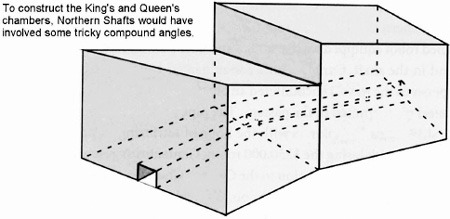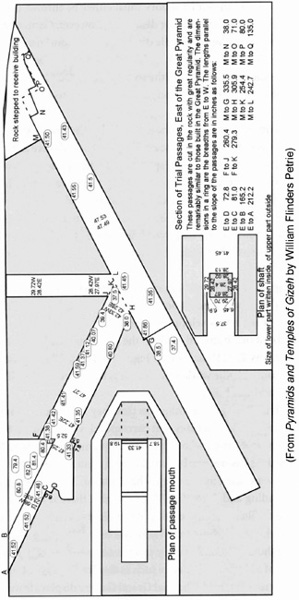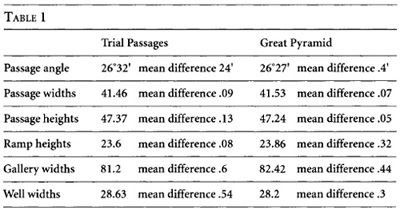The Giza Power Plant (4 page)

Without the presence of at least one mummy, what proof is offered to support the tomb theory? Inscriptions in the masonry of some of the pyramids have been interpreted as belonging to various dignitaries and generally are offered as the most conclusive proof of ownership of the pyramids. The presence of granite boxes that look like caskets in some of the pyramids is presented as more proof. This "proof", however, identifies only geometry and craftsmanship, not support for a theory that is highly subjective and based entirely on speculation.
The geometry and craftsmanship in the Great Pyramid have been topics of great interest and speculation for centuries. Lacking any evidence that a body was ever entombed there, but still clinging to their views, orthodox Egyptologists have been obliged to provide an explanation for the peculiar features of its passages and chambers. How do they explain the Descending Passage, Subterranean Pit, Ascending Passage, Horizontal Passage, Queen's Chamber, Grand Gallery, Antechamber, and the five superimposed chambers that overlay the King's Chamber? What explanation is given for the shafts that run from the King's and Queen's chambers to the outside? According to many Egyptologists, the entire interior complex of the Great Pyramid was the result of Khufu's, or the ancient artchitect's, indecision and symbolic reasoning. It appears that the ancient Egyptians changed their minds a lot, which resulted in some very expensive rework. I.E.S. Edwards described King Khufu as capricious in his monumental undertaking: "Externally, the Great Pyramid appears to have been completed without undergoing any significant changes in its original plan. But internally, great changes were made as construction
proceeded."
13
Edwards relates that the builders dug the Descending Passage down to the Subterranean Pit with
the intention of having it serve as a burial chamber. A second chamber probably would have been added to the end of the passage that runs south from this chamber, but, according to Edwards, the builders abandoned the entire underground burial plan.
Having changed their minds about a subterranean burial, Edwards says, the builders cut an opening in the ceiling of the Descending Passage and constructed the upward-sloping Ascending Passage, the Horizontal Passage, and then the erroneously named Queen's Chamber. However, the builders changed their minds again. According to Edwards, the plan was abandoned and work began on the Grand Gallery with its corbeled walls and 28-foothigh ceiling reaching deep into the heart of the pyramid to where the granite King's Chamber is now situated. Obviously, Khufu's men were very obliging, even though they had to haul the granite from a quarry five hundred miles away.
To many Egyptologists, therefore, the Grand Gallery is a glorious passageway to the king's final resting place, and the two chambers inside the Great Pyramid are the result of indecision on the part of the builders or the reigning monarch who directed its construction. All the other features of the Great Pyramid are explained away as being either symbolic or culticâor they are not explained at all. For example, according to Edwards, the northern so called "air shaft," which pierces the mass of the Great Pyramid with gun barrel precision, actually served no practical purpose and was retained only as a symbolic gesture to the traditional downward-sloping corridors of other tombs. He wrote, "These narrow shafts have often been referred to as air channels, but that was not their purpose. The northern shaft was evidently a replica in miniature of the traditional downward-sloping entrance corridor. And so we see yet another example of an architectural element being reproduced out of its original context. It would certainly not have been retained unless a special significance had been attributed to it." Citing a reference in the Pyramid Texts to the constellation of Orion, in explanation of the southern air shaft, Edwards claimed, "Once every 24 hours, three stars in the constellation passed directly over the axis of the shaft. With its aid, the King could make his ascent to their celestial region and return at will to his
tomb."
14
The explanation for the five overlaying chambers above the King's Chamber was purely a guess at the time of their discovery. It is logical and
easy to ask, "What is this for?" But it is sometimes difficult to answer, "I don't know." So when Howard-Vyse discovered the five chambers above the King's Chamber, he speculated that they were included in the design to provide a buffer between the flat ceiling in the King's Chamber and the thousands of tons of masonry above. This guess was accepted on blind faith by others and has been repeated so often it has become ingrained. This explanation for the overlying chambers has not been questioned by Egyptologistsâor any other researcher, for that matter. It may be argued that because the King's Chamber was at one time subject to a powerful forceâthe chamber walls show evidence of having undergone a violent repositioningâand the ceiling did not collapse, Howard-Vyse guessed correctly. However, as I will point out in more detail later in the book, this is a fallacious argumentâthe disturbance of the King's Chamber is attributed to an earthquake, but no other chambers suffered that fate.
The traditional tomb theory has been constantly drummed into us by documentaries, books, and movies. But despite its predominance, it continues to be questioned. On a more positive note, recently uncovered evidence has prompted some Egyptologists to revise aspects of the theory.
In 1993, Rudolph Gantenbrink, a German robotics engineer, explored the northern shaft leading from the Queen's Chamber using a specially designed robot equipped with a camera and laser pointer. Approaching a sharp bend in the shaft, Gantenbrink's robot, named Upuaut II (Upuaut means "opener of the ways") encountered an obstacle in its path. There was a length of steel pipe jammed in the passage. The pipe presumably was inserted into the shaft by early explorers with the hope of retrieving some artifacts. Not wanting to risk losing the $250,000 robot, Gantenbrink rescued it from this shaft and turned his attention to the Queen's Chamber southern shaft. During this tense mechanical expedition, Gantenbrink made a sensational discovery: At a level that is higher than the King's Chamber, his robot encountered a dead end, with what has been described as a "door" through which protruded two copper fittings. The implications of this discovery were immediately apparent, and created quite a dilemma for Egyptologists. According to their theories, Khufu changed his mind about being buried in the middle chamber in favor of a chamber higher up inside the pyramid. So if the so-called Queen's Chamber was abandoned for the higher chamber, it
would not make sense for the builders to continue to create these shafts as the construction of the pyramid continued.
In order to construct these shafts, the builders had to use a tremendous amount of care. The blocks needed to be cut on an exact angle and fitted together with precision. More care would have been necessary when constructing the northern shaft because the shaft does not go straight through the pyramid. With the same angle in reference to a horizontal plane, the shaft veers to the left to bypass the Grand Gallery and then veers back again once the gallery is cleared. The blocks that were manufactured to accommodate this angle had to have been cut on a compound angle. What we have, then, are a large number of limestone blocks that are precision cut with a bottom surface that is cut on an angle (see Figure 3). Parallel to this surface a rectangular channel is cut to form the walls and ceiling of the shaft. The existence of these shafts, and the precision with which they were manufactured, cannot be explained within the framework set forth by many Egyptologists; thereby they undeniably weaken the tomb theory. I will discuss a more logical purpose for these shafts later in the book.

F
IGURE
3.
Example of Blocks Used to Create Pyramid Shaft
Rudolph Gantenbrink's important discovery has forced many Egyptologists to finally accept that their theories are flawed. This is an interesting development. Academic mores normally dictate that when a theory contains flaws, or unsubstantiated data that supports critical elements on which
the theory is built, the entire theory must either be thrown out or revised. Instead of the tomb theory being dismissed, however, Gantenbrink himself was dismissed from the project. He discovered the "door" on March 22, 1993. A week later, he was told to pack up his robot and leave Egypt. Gantenbrink has the technology to go beyond the so-called door but, presumably because of political reasons, has been refused permission to resume his research in Egypt.
Gantenbrink, with an engineer's typical pragmatism, stated, "I take an absolute neutral position. It is a scientific process, and there is no need whatsoever to answer questions with speculation when these questions could be answered much more easily by continuing the research. Yet because of a stupid feud between what I call believers and non-believers, I am condemned as someone who is speculating. But I am not. I am just stating the facts. We have a device [ultrasonic] that would discover if there is a cavity behind the slab. It is nonsensical to make theories when we have the tools to discover the
facts."
15
Along with the recent discovery of the termination of the Queen's Chamber shaft, there is additional evidence that has been available for over a hundred years, but is seldom mentioned by Egyptologists. Cut into the bedrock about one hundred yards to the east of the Great Pyramid are features known as Trial Passages (see Figure 4). It is theorized that they were excavated to enable the workers to practice and perfect their skills before the Great Pyramid was built.
The Trial Passages are unique in that they are cut purely into the bedrock, yet they do have features that correspond with elements that are constructed, not excavated, within the Great Pyramid. A shortened version of the Descending Passage can be found as well as an Ascending Passage that is cut on the same angle as the one in the pyramid. At the juncture where the trial Descending and Ascending Passages meet there is a vertical shaft that must have fulfilled some need that the builders did not find necessary to include in the Great Pyramid. Where the trial Ascending Passage and the bottom of the trial Grand Gallery meet is an indentation that merely hints at the start of a Horizontal Passage such as that leading to the Queen's Chamber in the actual pyramid. The trial Grand Gallery displays features found in the Great Pyramid Grand Gallery, notably the steeply rising angle and the
side ramps. The dimensions and angles of all these puzzling excavations are almost exactly the same as those in the Great Pyramid.

FIGURE 4.
Trial Passages
William Flinders Petrie went further in describing these Trial Passages with tables of dimensions comparing the Trial Passages with various parts of the Great Pyramid. Table 1 is a reconstruction based on Petrie's table, using his
dimensions.
16

The hypothesis that these passages were "trial runs" is questionable, especially when the following observations are considered:
- The passages in question were cut into the bedrock of the plateau. This would require a different technique than those used to duplicate these features inside the Great Pyramid. The excavating skills developed in digging these tunnels would, in all probability, be redundant when the builders turned to constructing the Great Pyramid.
- These "trial passages" are the only ones found on the Giza Plateau. If there had been others of lesser quality, it could be argued that the builders needed the practice, but it is evident by the close similarity between these passages and the ones in the Great Pyramid that the builders knew exactly what they were doing. They already possessed the necessary skills needed to incorporate these features inside the Great Pyramid, making such an exercise, if that is what it was, unnecessary.
